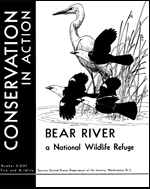United States Fish and Wildlife Service

United States Fish and Wildlife Service: Publications
Date of this Version
1-2002
Citation
Gilbart, Meghan. 2012. Under Cover: Wildlife of Shrublands and Young Forest. Wildlife Management Institute. Cabot VT. 87 pages.
Abstract
The term “early successional habitat” describes the shrubs, trees, and other plants that grow back on the land after older vegetation has been removed or cut back. We can visualize this important habitat type as all the stages of plant growth from open grasslands to young forest. Historically, these habitats were created by natural disturbances, extreme physical conditions such as poor soils or harsh climates, the abandonment of agricultural land, and logging. In recent years, human development has greatly reduced the amount of land available to wildlife, and many of the disturbances that once gave rise to early successional habitat – fire, extensive areas of flooding caused by beavers, and heavy logging – have been suppressed (Trani et al. 2001). As a result, populations of wildlife that need early successional habitat have fallen drastically (Litvaitis, 1993; Thompson & Dessecker, 1997).
In addition to grasslands, important early successional habitats include shrublands and young forest.
Shrublands are dominated by sparse-to-dense shrubs intermixed with young trees, vines, and herbaceous vegetation. Shrublands may develop in abandoned fields. They may persist in areas with poor soils or following repeated disturbances such as flooding or fire, although eventually the young trees will outcompete the shrubs as the vegetation inexorably matures to become forest.
Young forest typically has a dense understory where tree seedlings and saplings, woody vines, shrubs, and herbaceous vegetation grow together. If a mature forest canopy is removed – by logging, fire, or windstorm – and an understory of tree seedlings and saplings is left intact, a young forest composed of late-successional tree species will rapidly spring up, and will persist for 10 to 20 years, until the canopies of the maturing trees knit together and block sunlight from reaching the ground.
Because their canopies intercept most of the light, older forests generally do not support a densely vegetated understory. However, mature forests typically will have scattered patches of thick understory growth where small light-admitting gaps have opened in the canopy after trees have died or fallen down. Beneath the more-open forest canopies of certain tree species, higher light levels can spur the growth of different plants, including shrubs and herbaceous vegetation that attract insect pollinators (Bouget and Duelli, 2004). Such forest stands can support high insect populations (Greenberg, 2001), offering important food to birds, mammals, reptiles, and amphibians.
Young forest and shrublands tend to have a greater variety of fruiting shrubs and herbaceous vegetation than mature forests of any species composition. Seasonally or year-round, many kinds of wildlife, including mammals and young birds that have recently left the nest, feed on these plants and the insects they attract (Askins, 2001; Anders et al. 1998; Vega Rivera et al. 1998). Studies have shown that forest habitats with a dense understory can support abundant wildlife (MacArthur & MacArthur 1961; Conner et al. 1983; Rice et al. 1984; Schulte & Niemi, 1998). In general, habitats with a higher structural diversity of cover will support a greater diversity of wildlife.

